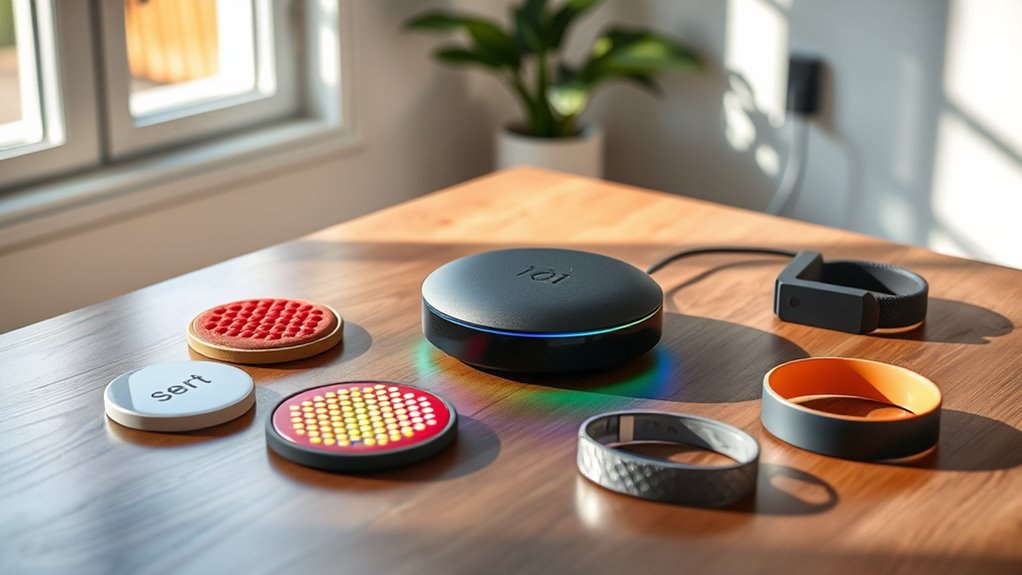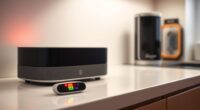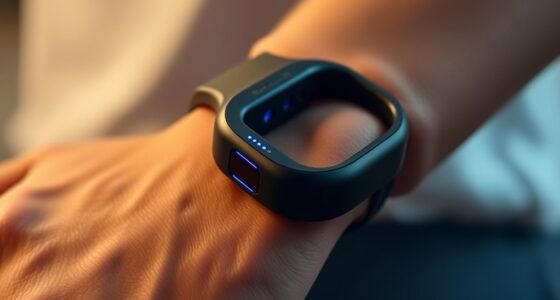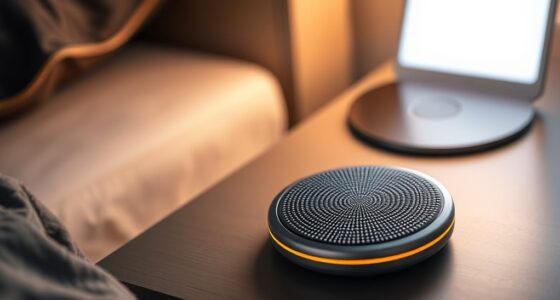To integrate deaf alerts into your smart home hub, start by choosing a compatible system that supports visual and vibration notifications. Connect your smart devices like lights, doorbell cameras, and vibration accessories, then configure alert rules through the hub’s app or control panel. Customize signals to suit your needs, test them for visibility and effectiveness, and keep your system updated. Continue exploring to discover detailed steps to enhance your home’s accessibility and safety.
Key Takeaways
- Select a compatible smart hub supporting deaf alert features, such as Samsung SmartThings or Hubitat.
- Connect compatible devices like flashing lights, doorbell cameras, and vibration accessories to the hub.
- Access the hub’s app or control panel to configure alert rules and set triggers for specific events.
- Customize visual and vibration notifications with preferred flashing patterns, colors, and tactile feedback.
- Test and regularly update alert settings to ensure clear, effective notifications for safety and accessibility.
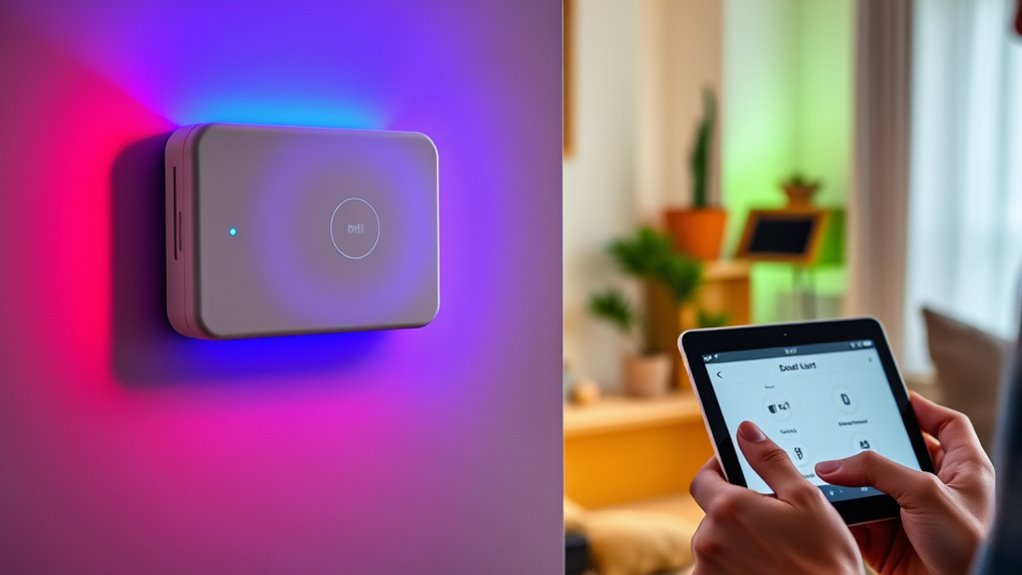
Smart home hubs are transforming how we manage household alerts, especially for deaf and hard-of-hearing users. When you integrate deaf alerts into your smart hub, you gain a dependable way to stay informed about important events around your home without relying solely on sound. Visual notifications are a core feature, allowing the hub to display flashing lights, on-screen messages, or color cues that catch your attention instantly. These notifications can alert you to everything from doorbells ringing to smoke alarms, ensuring you’re always aware of critical situations even if you can’t hear them.
Vibration alerts are another essential component of deaf alert integration. When a significant event occurs, your smart home hub can send a gentle or intense vibration through connected devices like smartwatches, vibration pads, or even bed shakers. This tactile feedback provides a discreet, immediate alert that something needs your attention. Combining visual notifications with vibration alerts creates a multi-sensory system that markedly reduces the chance of missing an alert, giving you peace of mind and greater independence at home.
To set this up, start by choosing a compatible smart home hub that supports deaf alert features. Many popular platforms, such as Samsung SmartThings or Hubitat, offer customizable alert options. Once you’ve selected your hub, connect it with compatible smart devices—like smart lights, doorbell cameras, and vibration accessories—that can be programmed to respond to specific triggers. You’ll need to access the hub’s app or control panel, where you can configure alert rules. For example, you can set the smart lights to flash red when the doorbell rings and have your vibration device activate simultaneously. This layered approach ensures multiple alerts occur in tandem, making sure you don’t miss critical notifications.
Next, customize the visual notifications for each type of alert. You might choose a bright flashing pattern for fire alarms or a color change for package deliveries. Test each notification to confirm it’s noticeable and quick to catch your eye. Simultaneously, set up vibration alerts tailored to your preferences—some may prefer a gentle buzz, while others might need a stronger shake. The goal is to create an intuitive system that signals different alerts clearly and promptly, without causing unnecessary disruptions.
Finally, regularly review and update your alert configurations to adapt to changing needs or new devices. Keep your smart hub’s firmware and connected devices up to date for best performance. Incorporating visual notification techniques and other accessible features enhances safety and independence, making your smart home truly inclusive for deaf and hard-of-hearing users.
Frequently Asked Questions
What Are the Best Deaf Alert Devices Compatible With Smart Hubs?
You should look for visual alert systems like flashing lights or strobe alarms, which easily connect to smart hubs. Wearable alert devices, such as vibrating wristbands or necklaces, are also excellent options for discreet notifications. Make sure these devices are compatible with your smart home hub, allowing seamless integration. This way, you’ll get reliable alerts for doorbells, alarms, or emergencies, keeping you informed and safe effortlessly.
How Do I Customize Deaf Alert Notifications for Different Emergencies?
To customize deaf alert notifications for different emergencies, you can adjust visual customization and notification preferences in your smart home hub settings. First, access the alert settings menu, then select the specific emergency types, like fire or intrusion. From there, you can choose how you receive alerts, such as flashing lights or on-screen notifications, ensuring you’re promptly and clearly informed based on your preferences and the type of emergency.
Can Deaf Alerts Be Integrated With Existing Smart Home Systems?
They say, “Where there’s a will, there’s a way,” and yes, deaf alerts can be integrated with your existing smart home systems. You just need to take into account privacy concerns and device interoperability. Make sure your devices support compatible protocols, and check privacy settings to protect sensitive data. By doing so, you create a seamless, effective alert system that keeps you safe and connected without compromising your privacy.
What Security Measures Protect Deaf Alert Data?
You should know that your deaf alert data is protected by strict privacy protocols and robust encryption standards. These measures confirm that your information stays private and secure from unauthorized access. Smart home systems typically use end-to-end encryption, making it difficult for hackers to intercept or tamper with your alerts. Always check that your device updates include the latest security features to keep your data safe.
Are There Cost Differences Between Various Deaf Alert Solutions?
Did you know that some deaf alert solutions can cost up to 50% less than others? When you compare costs, it’s essential to take into account affordability factors like features and compatibility. The cost comparison varies widely depending on the technology and provider, so you should evaluate what fits your budget and needs. This way, you can find an effective deaf alert system without overspending.
Conclusion
By integrating deaf alerts into your smart home hub, you’re opening the door to a more inclusive living space. Think of it as adding a new sense to your home—making it more aware and responsive to everyone’s needs. With just a few simple steps, you turn your smart home into a symphony of signals that everyone can hear, see, and feel. Embrace these changes, and watch your home become a true sanctuary for all.

